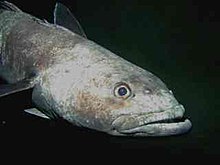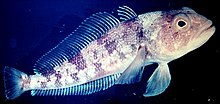Nototheniidae
- In some scientific literature, the term "cod icefish" is used to identify members of this family. This should not be confused with the term "icefish," which refers to the "white-blooded" fishes of the family Channichthyidae. See Icefish (disambiguation).
| Cod icefishes | |
|---|---|

| |
| Head of Antarctic toothfish (Dissostichus mawsoni) in McMurdo Sound | |
| Scientific classification | |
| Domain: | Eukaryota |
| Kingdom: | Animalia |
| Phylum: | Chordata |
| Class: | Actinopterygii |
| Order: | Perciformes |
| Suborder: | Notothenioidei |
| Family: | Nototheniidae Günther, 1861[1] |
| Genera | |
|
see text | |
Nototheniidae, the notothens or cod icefishes, is a family of ray-finned fishes, part of the suborder Notothenioidei which is traditionally placed within the order Perciformes. They are largely found in the Southern Ocean.
Taxonomy
Nototheniidae was described as a family in 1861 by the German-born British ichthyologist Albert Günther with the type genus being Notothenia which had been described in 1844 by Sir John Richardson with the species Notothenia coriiceps which Richardson had also described in 1844 subsequently being designated as the type in 1862 by Theodore Nicholas Gill.[2] The name Notothenia means “coming from the south”, a reference to the Antarctic distribution of the genus.[3] They are traditionally placed in the order Perciformes together with their relatives,[4] Actual phylogenetic relationships among species of suborder Notothenioidei have not yet been determined with certainty.[5]
Genera
The following subfamilies[1] and genera are classified within the family Nototheniidae:[6][2]
- Pleuragrammatinae Andersen & Hureau 1979
- Aethotaxis H. H. DeWitt, 1962
- Dissostichus Smitt, 1898
- Gvozdarus Balushkin, 1989
- Pleuragramma Balushkin, 1982
- Nototheniinae Günther 1861
- Gobionotothen Balushkin, 1976
- Lepidonotothen Balushkin, 1976
- Lindbergichthys Balushkin, 1979
- Notothenia Richardson, 1844
- Nototheniops Balushkin, 1976
- Paranotothenia Balushkin, 1976
- Patagonotothen Balushkin, 1976
- Trematominae Balushkin,1982
- Cryothenia Daniels, 1981
- Pagothenia Nichols & La Monte, 1936
- Trematomus Boulenger, 1902
These subfamilies are not recognised in the 5th Edition of Fishes of the World.[4]
Characteristics
Nototheniidae fishes have fusiform or elongate and oblong bodies. They typically have two dorsal fins, the first having 3 to 11 spines and the second having 25-42 segmented fin rays. The anal fin is similar to the second dorsal fin and has 22 to 40 segmented rays. All but the last dorsal and anal fin rays are branched. The caudal fin is rounded to forked and the pectoral fins are large. The mouth is terminal and may be horizontal or angled with a protrusible upper jaw. There are no teeth on the roof of the mouth. in most species there are no spines on the preoperculum or operculum. Any scales are usually ctenoid although the spinules may be reduced or absent. They have between 1and 3 lateral lines.[7] They vary in size from. Total length of 11 cm (4.3 in) in Patagonotothen cornucola to 215 cm (85 in) in the Patagonian toothfish (Dissostichus eleginoides).[6]
Distribution and habitat
Nototheniidae species are largely found in the Southern Ocean and are particularly abundant off the shores of Antarctica.[7] As the dominant Antarctic fish taxa, they occupy both sea-bottom and water-column ecological niches.[8]
Biology
Nototheniidae species have no swim bladder, however, they have other depth-related adaptations, such as increased fatty tissues and reduced mineralization of the bones, resulting in a body density approaching neutral, to fill a variety of niches.[8] The spleen may be used to remove ice crystals from circulating blood.[9][10] As the chilly Antarctica and sub-Antarctic waters of the Southern Ocean average −1 to 4 °C (30–39 °F),[11] most species of these regions produce antifreeze glycoproteins to prevent the formation of ice crystals in blood and other body fluids.[12]
Some species exhibit polymorphism, for example, the circum-Antarctic Trematomus newnesi exists as two morphs in the Ross Sea, the typical morph and a large-mouthed/broad-headed morph.[13]
Fisheries
Nototheniidae species are the major fish resource in the Southern Ocean, many notothens are under increasing pressure from commercial fishing, particularly the Patagonian toothfish and the Antarctic toothfish.[14]


References
- ^ a b Richard van der Laan; William N. Eschmeyer & Ronald Fricke (2014). "Family-group names of Recent fishes". Zootaxa. 3882 (2): 001–230. doi:10.11646/zootaxa.3882.1.1. PMID 25543675. Retrieved 9 September 2021.
- ^ a b Eschmeyer, William N.; Fricke, Ron & van der Laan, Richard (eds.). "Genera in the family Nototheniidae". Catalog of Fishes. California Academy of Sciences. Retrieved 15 September 2021.
- ^ Christopher Scharpf & Kenneth J. Lazara, eds. (12 April 2021). "Order Perciformes: Suborder Notothenoididei: Families Bovichtidae, Pseaudaphritidae, Elegopinidae, Nototheniidae, Harpagiferidae, Artedidraconidae, Bathydraconidae, Channichthyidae and Percophidae". The ETYFish Project Fish Name Etymology Database. Christopher Scharpf and Kenneth J. Lazara. Retrieved 15 September 2021.
- ^ a b J. S. Nelson; T. C. Grande; M. V. H. Wilson (2016). Fishes of the World (5th ed.). Wiley. p. 465. ISBN 978-1-118-34233-6.
- ^ Near, TJ; et al. (2004). "Phylogenetic investigations of Antarctic notothenioid fishes (Perciformes: Notothenioidei) using complete gene sequences of the mitochondrial encoded 16S rRNA". Molecular Phylogenetics and Evolution. 32 (3): 881–891. doi:10.1016/j.ympev.2004.01.002. PMID 15288063.
- ^ a b Froese, Rainer; Pauly, Daniel (eds.). "Family Nototheniidae". FishBase. June 2021 version.
- ^ a b H.H. Dewitt; P.C. Heemstra; and O. Gon (1990). "Nototheniidae Notothens". In O. Gon and P.C. Heemstra (eds.). Fishes of the Southern Ocean. South African Institute for Aquatic Biodiversity. ISBN 9780868102115.
- ^ a b Eastman, Joseph (1993). Antarctic Fish Biology: Evolution in a Unique Environment. Academic PressSan Diego, California.
- ^ Vacchi, M; et al. (2017). The Antarctic Silverfish: a Keystone Species in a Changing Ecosystem. Springer International Publishing.
- ^ Farrell, AP & Steffensen, JF (2005). The Physiology of Polar Fishes. Elsevier.
- ^ "Surface Temperature - NOAA's Science On a Sphere". National Oceanic and Atmospheric Administration. 2018.
- ^ Chen, L; et al. (1997). "Evolution of antifreeze glycoprotein gene from a trypsinogen gene in Antarctic notothenioid fish". PNAS. 94 (8): 3811–3816. Bibcode:1997PNAS...94.3811C. doi:10.1073/pnas.94.8.3811. PMC 20523. PMID 9108060.
- ^ Eastman, JT & DeVries, AL (1997). "Biology and phenotypic plasticity of the Antarctic nototheniid fish Trematomus newnesi in McMurdo Sound". Antarctic Science. 1 (1): 27–35. Bibcode:1997AntSc...9...27E. doi:10.1017/S0954102097000047. S2CID 27173180.
- ^ "Back on the menu How smarter fishing practices, improved management and MSC certification have transformed toothfish's fortunes". Marine Stewardship Council. 2018. Retrieved 16 September 2021.
